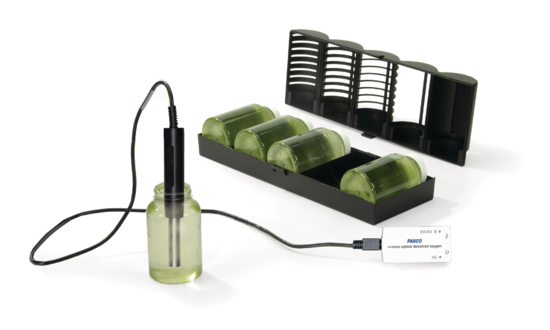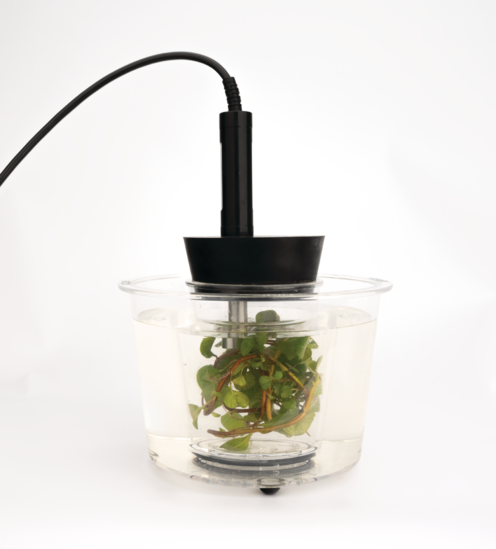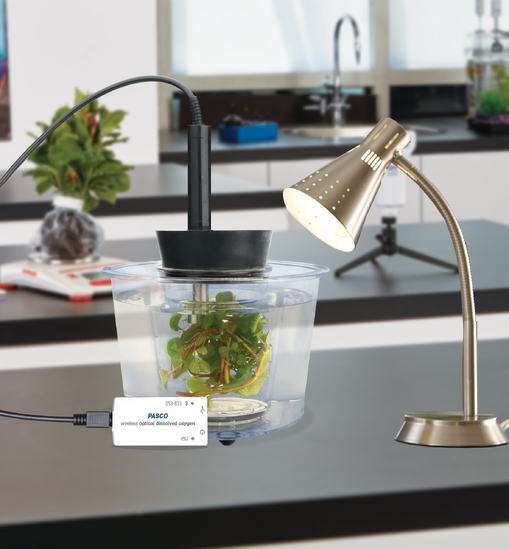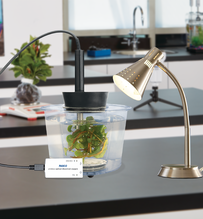
Optical dissolved oxygen sensor smaller form









The redesigned small form optical dissolved oxygen sensor is compatible with all standard 12 mm probe classroom stands and stoppers.
See the Buying Guide for this item's required, recommended, and additional accessories.
Product Summary
The Wireless Optical Dissolved Oxygen (ODO) Sensor is ideal for monitoring DO2 in the lab or field. The new design takes the circuitry of our previous version (PS-3224) and compacts it into a much smaller form factor for easier use with bench scale equipment. The new design follows the standard probe tip (12 mm) shape and size shared by most solution-based probes and the equipment that houses them; this upgrade allows for elegant use in classroom settings regardless if you utilize beakers, flasks, or PASCO's Photosynthesis Tank or Chamber. Plus, the 3 meter cable allows students to easily measure oxygen levels in class aquariums, reaction vessels, as well as from the shores of creek or wetland sites.
The Wireless ODO Sensor automatically compensates for temperature and pressure when reporting values, and the optical technology is accurate, fast, and does not require stirring, filling solutions, warm-up, or frequent calibration.
Remotely log data using the sensor's built-in memory, or stream your data to your device in real time. After collecting data for hours (or even days!), simply connect the sensor to your device to download your data. With this powerful sensor, educators can explore day and night nutrient cycles, changes in metabolic processes, seasonal changes in water quality, and more.
Product Specifications
| Range | 0 to 20 mg/L, 0 to 200% saturation |
| Resolution | 0.01 mg/L |
| Accuracy (with calibration) | ±0.2 mg/L or 1% (whichever is greater) |
| Accuracy (out of the box) | ±0.5 mg/L or 3% (whichever is greater) |
| Response Time | 90% in 20 sec |
| Measurements | Concentration (mg/L), Saturation (%), O2 Gas (in air, qualitative) (%), Temperature (°C) |
| Waterproof Depth (probe) | Length of cable (3m) |
| Splash Resistance of Bluetooth Sensor Box | Not submersible (wipe dry if splashed) |
| Cable Length | 3 m |
| Connectivity | USB and Bluetooth 5.2 |
| Logging | Yes |
| Battery Type | Rechargeable LiPo |
Battery & Logging
| Stored Data Points Memory (Logging) | >25,000 |
| Battery - Connected (To Data Collection Device) | > 40 hrs |
| Battery - Logging (Data Logging Mode) | 45 hrs |
| Battery Type | LiPO |
1 Minimum # of data points with all measurements enabled, actual results depend on enabled measurements.
2 Continuous use in a connected state until battery failure, actual results will depend on sample rate, active measurements, and battery condition.
3 Logging until battery failure, actual results will depend on sample rate, active measurements, and battery condition.
* Normal classroom use is the sensor in active use for 20min/lab for 120 lab periods/yr.
Data Collection Software
This product requires PASCO software for data collection and analysis. We recommend the following option(s). For more information on which is right for your classroom, see our Software Comparison: SPARKvue vs. Capstone »
Connectivity Options
This product can connect directly to your computer or device with the following technologies. No Interface required. See the following guide for details regarding device compatibility: Wireless Bluetooth Product Compatibility »
Buying Guide
| Recommended Accessories | P/N | Price |
|---|---|---|
| NewPhotosynthesis Chamber | PS-3251 | -- |
| Aquatic Productivity Bottles | ME-6937 | -- |
| Also Available | P/N | Price |
|---|---|---|
| EcoChamber | ME-6667 | -- |
| EcoZone System | ME-6668 | -- |
| Photosynthesis Tank | PS-2521B | -- |
Experiment Library
Perform the following experiments and more with the Wireless Optical Dissolved Oxygen Sensor.
Visit PASCO's Experiment Library to view more activities.
Blockly Extension: Fish Tank Water Quality
Students will use an optical dissolved oxygen sensor and Blockly code to write a program that helps children understand the relationship between the amount of oxygen dissolved in fish tank water and the comfort level of a freshwater...
What Factors Affect Dissolved Oxygen?
Students will use a dissolved oxygen sensor to determine how different factors affect the concentration of dissolved oxygen in water.
Photosynthesis and Respiration with Algae Beads
Students use a Wireless Optical Dissolved Oxygen Sensor (PS-3246) and a Photosynthesis Chamber (SE-3251) to compare the metabolism of algae beads in light and dark conditions.
Cellular Respiration in Yeast (Optical Dissolved Oxygen)
Students use a Wireless Optical Dissolved Oxygen sensor and a Photosynthesis Chamber to investigate the effect of temperature on the cellular respiration rate of yeast cells.
Enzyme Action (Optical Dissolved Oxygen)
Students use a Wireless Optical Dissolved Oxygen (ODO) sensor and (optional) Photosynthesis Chamber to compare the rate of hydrogen peroxide decomposition with and without a catalyst.
Support Documents
| Manuals | ||
|---|---|---|
| Wireless Optical Dissolved Oxygen Sensor Manual | English - 374.26 KB | |















